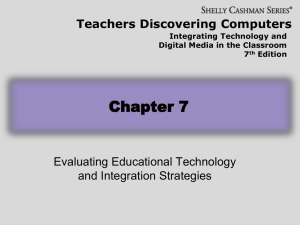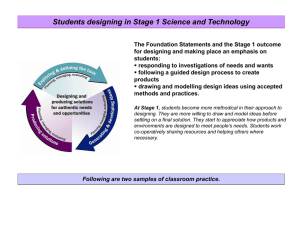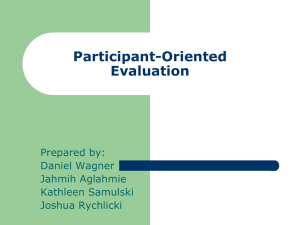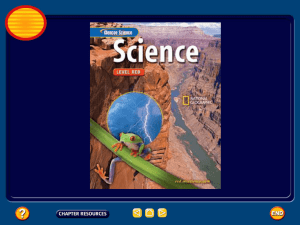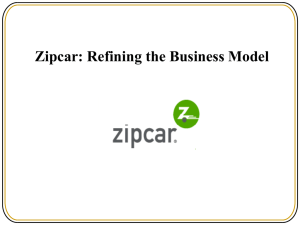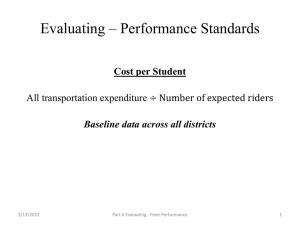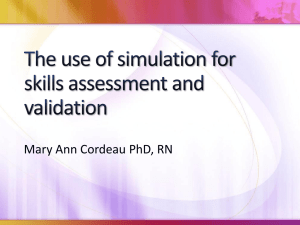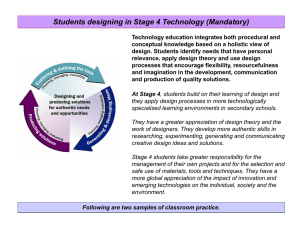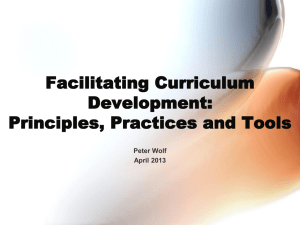Evaluating Educational Technology and Integration Strategies
advertisement
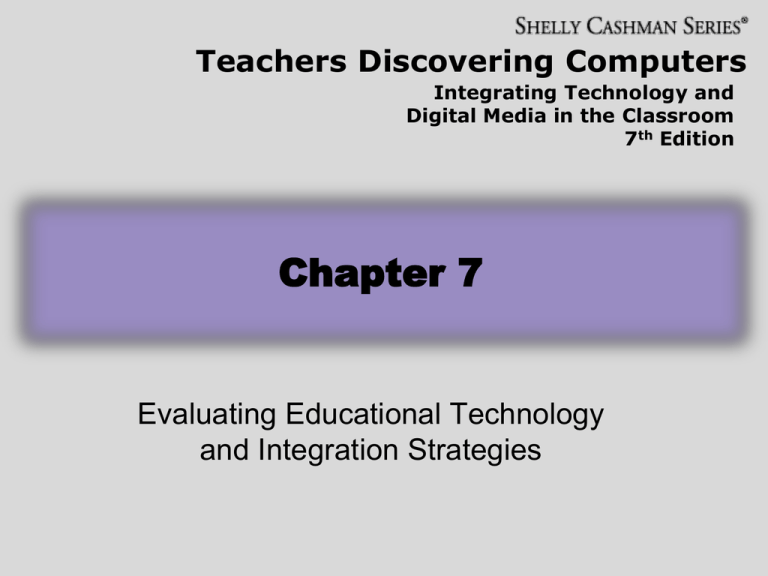
Teachers Discovering Computers Integrating Technology and Digital Media in the Classroom 7th Edition Chapter 7 Evaluating Educational Technology and Integration Strategies Chapter Objectives Identify sources of information for evaluating educational technology and digital media Outline the considerations and tools used to evaluate software applications, including apps Describe and explain the key criteria used to evaluate Web resources Describe the tools for evaluating the effectiveness of technology Describe ways to integrate technology into specific curriculum subject areas Identify and compare possible sources of funding for classroom technology Chapter 7: Evaluating Educational Technology and Integration Strategies 2 Evaluating Educational Technology Evaluating the appropriateness and effectiveness of educational technology is an important aspect of integrating current technologies into your classroom curriculum Evaluate before, during, and after instruction Chapter 7: Evaluating Educational Technology and Integration Strategies 3 Evaluating Educational Technology Sources of Information Numerous resources and technologies to choose from School districts and state Departments of Education Lists of recommended software, including apps Chapter 7: Evaluating Educational Technology and Integration Strategies 4 Evaluating Educational Technology Professional educational organizations Local, state, regional, national, and international educational organizations Web sites for organizations Chapter 7: Evaluating Educational Technology and Integration Strategies 5 Evaluating Educational Technology Apps Reviews Evaluated by users and reviews are listed with other information about the app Often includes integration ideas Colleague Recommendations Discuss issues with other educators Often based on firsthand experience Chapter 7: Evaluating Educational Technology and Integration Strategies 6 Evaluating Educational Technology Published evaluations See company’s Web site Educational journals Chapter 7: Evaluating Educational Technology and Integration Strategies 7 Evaluating Educational Technology Conferences National and state organizations Presentations Meet representative from hardware and software companies Chapter 7: Evaluating Educational Technology and Integration Strategies 8 Evaluating Educational Technology The Web Mailing lists EDTECH Forums Newsgroups Discussion groups Listservs Wikis Blogs Webinars Chapter 7: Evaluating Educational Technology and Integration Strategies 9 Evaluating Educational Technology Evaluating Software Programs Free trial versions Software/app evaluation rubrics Detailed assessment tool Chapter 7: Evaluating Educational Technology and Integration Strategies 10 Chapter 7: Evaluating Educational Technology and Integration Strategies 11 Evaluating Educational Technology Evaluating Software Programs Content Is the software/app valid? Relate content to school’s and state’s specific curriculum standards and related benchmarks Chapter 7: Evaluating Educational Technology and Integration Strategies 12 Evaluating Educational Technology Evaluating Software Programs Documentation and technical support Documentation Printed or online information Technical support Telephone or Web support Chapter 7: Evaluating Educational Technology and Integration Strategies 13 Evaluating Educational Technology Evaluating Software Programs Ability levels and assessment Can software or app be used with various ability and academic levels? Can software or app adjust the academic level and students move through the skills? Chapter 7: Evaluating Educational Technology and Integration Strategies 14 Evaluating Educational Technology Evaluating Software Programs Technical quality and ease of use Technical quality How well the software or app presents itself and how well it works Ease of use User friendliness Student opinion is important in these criteria Chapter 7: Evaluating Educational Technology and Integration Strategies 15 Evaluating Educational Technology Evaluating Web Resources Authority Is the author or organization clearly identified? Examine the credentials of the author or organization of the Web site Has the author or organization listed experience, position, education, or other credentials? Chapter 7: Evaluating Educational Technology and Integration Strategies 16 Chapter 7: Evaluating Educational Technology and Integration Strategies 17 Evaluating Educational Technology Evaluating Web Resources Affiliation Who is the Web site associated with? Examine the URL and domain name Chapter 7: Evaluating Educational Technology and Integration Strategies 18 Evaluating Educational Technology Evaluating Web Resources Purpose and Objectivity Is the content provided as a service? Is the content unbiased? Chapter 7: Evaluating Educational Technology and Integration Strategies 19 Evaluating Educational Technology Evaluating Web Resources Content and Learning Process Is the content valid and appropriate? Does the information relate to your needs? What topics are covered? For what level is the information written? Do the links within the site add value? Chapter 7: Evaluating Educational Technology and Integration Strategies 20 Evaluating Educational Technology Evaluating Web Resources Audience and currency Is the content suitable for your students? Is the content up to date and timely? Chapter 7: Evaluating Educational Technology and Integration Strategies 21 Evaluating Educational Technology Evaluating Web Resources Design Web effectiveness Web evaluation rubric Student Web Site Evaluation Rubric Chapter 7: Evaluating Educational Technology and Integration Strategies 22 Evaluating Educational Technology Chapter 7: Evaluating Educational Technology and Integration Strategies 23 Chapter 7: Evaluating Educational Technology and Integration Strategies 24 Integration Strategies One-Computer Classroom Use the computer for classroom presentations and demonstrations Introduce new concepts Students use to present assignments, projects, and research activities to the entire class Maintain class records, create presentations and projects, do research, and communicate with other teachers Chapter 7: Evaluating Educational Technology and Integration Strategies 25 Integration Strategies One-Computer Classroom Obtain Internet access Utilize educational software Enhance lectures and presentations Use the computer as a teaching assistant Foster group and cooperative learning Write an ongoing story Create a class blog Start a class newsletter Chapter 7: Evaluating Educational Technology and Integration Strategies 26 Integration Strategies One-Computer Classroom Maintain a student database Teacher productivity tool Optimize computer lab time New emerging technologies Chapter 7: Evaluating Educational Technology and Integration Strategies 27 Integration Strategies Multicomputer Classroom Multiple learning centers Integrate other technologies Miss Julie Davis’ classroom Digital camera Web research centers Develop presentations Chapter 7: Evaluating Educational Technology and Integration Strategies 28 Chapter 7: Evaluating Educational Technology and Integration Strategies 29 Integration Strategies Computer Labs/Media Centers All students have hands-on experience Often used to teach technology skills or subjectspecific skills Integrate computer-related skills into subjectdirected curriculum areas Example: Web scavenger hunt Chapter 7: Evaluating Educational Technology and Integration Strategies 30 Chapter 7: Evaluating Educational Technology and Integration Strategies 31 Curriculum Integration Activities Curriculum Resource Pages Strategy for implementing the Internet into the classroom Teacher-created document containing hyperlinks to teacher-selected Web sites that assist in teaching content-specific curriculum objectives Chapter 7: Evaluating Educational Technology and Integration Strategies 32 Chapter 7: Evaluating Educational Technology and Integration Strategies 33 Finding Funds to Support Classroom Technology Integration Many school districts do not have sufficient funding for technology If school cannot provide funds, turn to the public, industry, and the government Chapter 7: Evaluating Educational Technology and Integration Strategies 34 Finding Funds to Support Classroom Technology Integration Fund-raising Drives and Contests Partner with local businesses Small amounts of money can go a long way Enter contests to win equipment Involve parents and community Showcase students’ use of technology Volunteers Chapter 7: Evaluating Educational Technology and Integration Strategies 35 Finding Funds to Support Classroom Technology Integration Grants Funds provided by a funding source that transfers money, equipment, or services to the grantee Grantee is the teacher, school, or organization Sources: Department of Education, federal sources, foundations, and corporations Chapter 7: Evaluating Educational Technology and Integration Strategies 36 Finding Funds to Support Classroom Technology Integration Grants Request for proposal (RFP) Grant proposal Look for opportunities on the Web Chapter 7: Evaluating Educational Technology and Integration Strategies 37
